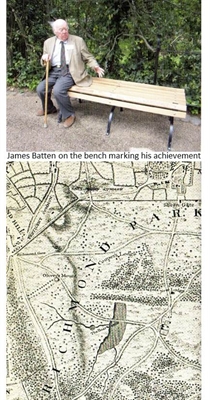One of the commonest questions asked by callers at the Richmond Park Visitor Centre is ‘Where can we see the view of St Paul’s Cathedral?’ That a view established 300 years ago survives to attract visitors from far and wide today is largely due to the detective skills and devotion of one man, James Batten.
It was James Batten who in 1976, following a clue on an 18th-century map, rediscovered the ‘keyhole’ vista of St Paul’s Cathedral from the top of King Henry’s Mound that was created soon after the Cathedral was completed in 1710. Neglected over the centuries, the vista was obliterated by growing bushes and trees during the Second World War, when gardeners were on wartime service.
James, now 85, had his interest in Richmond Park aroused when from the balcony of his family home in Strawberry Hill in the 1930s he looked across the Thames towards the long wooded ridge on the skyline. ‘It reminded me of the hills around Srinagar’, he says, recalling the first five years of his childhood in Kashmir as the son of a Gurkha Army officer. Onto the same balcony, when war came, ‘I would creep out to watch German aircraft caught in the searchlights, before my anxious family brought me indoors’.
Closer acquaintance with Richmond Park, however, had to wait a number of years. The military career pursued by James’s father and later by his stepfather led the family to Camberley and later to Wilton, near the military base at Salisbury. After education at Wellington College, James saw military service in Palestine where he was shot and wounded, and treated in hospital in Jerusalem. He then studied Political and Economic Geography at Caius College, Cambridge, where he recalls rooftop escapades with madcap colleagues. Vacations were often spent in Rome, where his stepfather was by then working. This proved a congenial setting for James to pursue a growing interest in architecture and history, fostered by his parents who had studied in these fields at Cambridge.
After graduating from Caius College, James served for two periods as ADC and Private Secretary to the Governor of Western Australia, interrupted by a voyage as ordinary seaman on a whaling ship: this unusual succession of jobs earned him at once membership of the Victorian Order – and of the Australian Workers’ Union. Later he became Private Secretary and ADC to the Governor-General of the Federation of Rhodesia and Nyasaland.
James returned to England in the late 1950s, working in Westminster Hall as assistant secretary to the UK branch of the Commonwealth Parliamentary Association. A keen skier, he became Secretary of the Lords and Commons Ski Club.
Living in a cottage on Ham Common, James came to love Richmond Park and take a particular interest in King Henry’s Mound. One of his prized possessions was a copy of a 1746 map of London by John Rocque. In Richmond Park this map showed an avenue of trees leading east from the Mound towards a further hillock, now lost, that is marked as Oliver’s Mount. During his time in Rome James had observed how vista lines lead the eye across the city from one fine building to another, and studying the Rocque map in the 1970s he speculated that the line of trees it showed might well follow one of these.
‘Soon I was up in The Park and realised that the dense holly hedge on the east side of King Henry’s Mound must hide a view of St Paul’s’. He forced his way through the hedge. ‘It was a blood-letting experience, fighting through prickly growth and tearing my trousers on the rusty remains of an arbour. As I stepped over it and parted the remaining holly, there it was: Wren’s masterpiece’.
Having rediscovered this 300-year-old vista, how was it to be saved? James had the whole-hearted support of the then Park Superintendent Mike Fitt, who initiated steps to enhance the Mound and to keep the view of St Paul’s clear of vegetation. A proposed development at Liverpool Street Station, which would have formed an unacceptable backdrop to the Cathedral, was successfully opposed and rejected. Further years of campaigning, with The Royal Parks and the Friends as allies, resulted in 1992 in statutory protection for ‘the strategic view and its viewing corridor’.
The battle seemed to be won – but was it ? With developers greedy for land and finding in Ken Livingstone an acquiescent Mayor, there came a proposal for a high-rise development which would have severely truncated the view. With the advent of Boris Johnson things took a brighter turn, as the new Mayor promised to respect the view’s protected status. However, celebrations were muted when it was learned that a large development near Victoria Station had already been given the go-ahead. As Friends’ planning adviser Max Lankester commented: ‘This seems a case of closing the stable door long after the horse has rampaged its way across our cherished landscape’.
The development now proceeding will leave the drum and dome of St Paul’s Cathedral unobstructed, with the sky as its background, but extend into the lower right-hand corner of the viewing ‘corridor’. The small section of the new building visible at this point could possibly be masked by allowing more foliage to develop in the line of sight. ‘We cannot turn the clock back’, says James, ‘but this must not become the thin end of the wedge; we must remain vigilant against any further threats to the view’.
The contribution of James Batten to this treasured feature of Richmond Park is justly honoured by a bench bearing his family name at the summit of the Mound, while the view indicator on the surrounding terrace showing the westward panorama towards Windsor Castle bears witness to his prowess as an artist.


